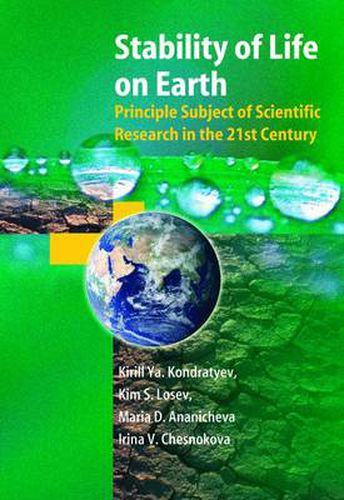Readings Newsletter
Become a Readings Member to make your shopping experience even easier.
Sign in or sign up for free!
You’re not far away from qualifying for FREE standard shipping within Australia
You’ve qualified for FREE standard shipping within Australia
The cart is loading…






This title is printed to order. This book may have been self-published. If so, we cannot guarantee the quality of the content. In the main most books will have gone through the editing process however some may not. We therefore suggest that you be aware of this before ordering this book. If in doubt check either the author or publisher’s details as we are unable to accept any returns unless they are faulty. Please contact us if you have any questions.
In Stability of Life on Earth, Professor Kondratyev and his team show that the concept of biotic regulation is of fundamental importance in solving a wide range of environmental and other problems. They put forward a new approach to the solution of old environmental problems. Beginning with a look at the geographic environment and structural units within it, they show that ecosystems represent a set of homogeneous, closely-correlated communities of organisms and their environment. Biologists call such correlated communities ?biogeocenoses?, and they are similar to the corporate structures in economic systems and interact competitively with each other. On the basis of competitive interaction in the biosphere, self-organisation and management take place. The authors show how human economic activity perturbed balances in natural biogeochemical cycles, eliminating and strongly modifying natural land cover, the 20th Century being the time when human activities ?collided? with Nature. They consider scientific bases for the stability and sustainability of life, and demonstrate how the scale and intensity of human-induced destruction of Nature and resultant feedback mechanisms have continuously expanded. They consider the likelihood of increasing numbers of natural disasters as a result of such activities, and propose that sustainable development should become a principal research topic during the 21st Century.
$9.00 standard shipping within Australia
FREE standard shipping within Australia for orders over $100.00
Express & International shipping calculated at checkout
This title is printed to order. This book may have been self-published. If so, we cannot guarantee the quality of the content. In the main most books will have gone through the editing process however some may not. We therefore suggest that you be aware of this before ordering this book. If in doubt check either the author or publisher’s details as we are unable to accept any returns unless they are faulty. Please contact us if you have any questions.
In Stability of Life on Earth, Professor Kondratyev and his team show that the concept of biotic regulation is of fundamental importance in solving a wide range of environmental and other problems. They put forward a new approach to the solution of old environmental problems. Beginning with a look at the geographic environment and structural units within it, they show that ecosystems represent a set of homogeneous, closely-correlated communities of organisms and their environment. Biologists call such correlated communities ?biogeocenoses?, and they are similar to the corporate structures in economic systems and interact competitively with each other. On the basis of competitive interaction in the biosphere, self-organisation and management take place. The authors show how human economic activity perturbed balances in natural biogeochemical cycles, eliminating and strongly modifying natural land cover, the 20th Century being the time when human activities ?collided? with Nature. They consider scientific bases for the stability and sustainability of life, and demonstrate how the scale and intensity of human-induced destruction of Nature and resultant feedback mechanisms have continuously expanded. They consider the likelihood of increasing numbers of natural disasters as a result of such activities, and propose that sustainable development should become a principal research topic during the 21st Century.